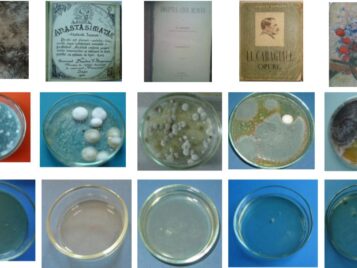Avant-garde design of nanomaterials and nanosystems with practical applications in the scientific preservation of Romanian cultural heritage
PN-II-RU-PD-2011-3-0023 (6PD/2011)
Cultural heritage and architectural monuments are exposed to environmental pollutants (inorganic and organic), climatic factors (temperature, humidity, rain and other precipitation, sun exposure) and chemical treatments (biocides, surfactants and hydrophobic compounds) that facilitate microbial growth resulting in transformations physical, chemical, but also aesthetic. These changes can cause irreversible damage, the phenomenon being known as biodeterioration. The biodegradation of cultural heritage and architectural monuments has been and is an area of interest for researchers around the world.
Project goal
The aim of the project is to propose new recipes to reduce the impact of biodegradation of heritage objects, recipes based on the innovative use of new synthetic chemical compounds with antifungal effect.
Contracting authority: Executive Unit for Financing Higher Education, Research, Development and Innovation (UEFISCDI)
Implementation period: 05/11/2011-05/04/2013
Budget: 155.970 lei
Project director: Dr. Chem. Radu Claudiu Fierăscu
The main objective of the project is the development of new methods involving nanomaterials for the restoration and conservation of cultural heritage. The main objective of the project is within the priorities of the national research-development-innovation strategy, and responds to the strategic objectives of the strategy (knowledge creation and increase of social quality). The project could also respond to another strategic objective (improving the competitiveness of the Romanian economy), if the results of the project will arouse the interest of companies involved in restoration and conservation.
In achieving the main objective, some specific objectives were taken into account:
- synthesis and characterization of (nano and micro) materials;
- the study of the restoration / conservation properties of the synthesized materials on the artifacts (ceramics, stone, paintings on paper and paper);
- establishing the best recipes to be applied in restoration and conservation;
During the project, synthetic chemical compounds were obtained and characterized analytically: hydroxyapatite (HAP), hydroxyapatite partially displaced with strontium (SrCaHAP), hydroxyapatite totally displaced with strontium (SrHAP), hydroxyapatite partially displaced with magnesium (MgCaHAP), hydroxyapatite totally displaced with magnesium (MgHAP), hydroxyapatite totally displaced with barium (BaHAP), magnesium hydroxide, calcium hydroxide, barium hydroxide and strontium hydroxide.
The analyzes performed (XRD, EDXRF, FTIR, thermal analyzes, DLS, ICP-AES) confirmed the synthesis of the materials of interest (in the case of the series of displaced hydroxyapatite revealing the isomorphic substitution) as well as the reduced particle sizes. A series of natural extracts (leurd, lavender, basil, etc.) were also obtained and characterized. Studies have shown the highest antifungal activity for HAP and SrHAP compounds.

The antifungal efficacy results obtained by the diluted inoculum technique on the surface of the culture medium were also confirmed by a variation of the Kirby-Bauer test. Following the tests performed on the artifacts, the most effective was the basil extract – SrHAP mixture.
The results of the project offer the possibility of obtaining a recipe for the removal of biodeteriogens, using synthetic chemical compounds and / or natural extracts, with the lowest possible costs and the highest possible efficiency. Studies in the field will continue after the end of the project, in order to deepen the mechanisms that lead to the removal of biodeteriogens, as well as to finalize a recipe that can be applied directly to affected artifacts, differentiated by type of artifact and biodeteriogens present.
The results obtained were validated by the scientific community, by publishing papers in ISI (European Journal of Science and Theology, Revue Roumaine de Chimie, Environmental Engineering and Management Journal) and BDI (SPIE Proceeding, Materials Protection)

Also, the results were presented in prestigious international scientific events: 4th Edition of the European Symposium on Religious Art Restoration and Conservation, Romanian Conference on Advanced Materials, Conference on Cultural Heritage and New Technologies, The XXII Congress of chemists and technologists of Macedonia, International Conference on Biodeterioration of Historical and Cultural Heritage, Biommed, ROMPHYSCHEM 15, etc.









